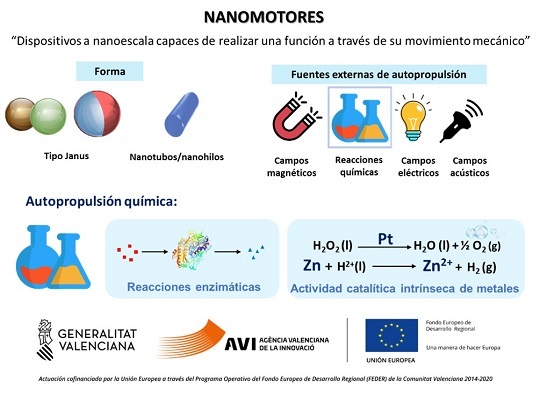
The development of self-propelled nano/microparticles (nano/micromotors) has aroused great interest in recent decades.
In this field, the UCIE of the IDM is working on the valorization of a nanomotor capable of disintegrating the protein matrix of bacterial and fungal biofilms, releasing drugs in a controlled and localized manner, causing the death of microorganisms. Once this nanomotor has been valued, it could be used in the field of dentistry for the treatment of endodontic infections and in the field of clinical microbiology for the removal of bacterial biofilms on different types of surfaces.
One of the most ambitious goals of nanotechnology is to develop systems that mimic the inherent functions of living entities, such as autonomous movement, communication, and the ability to recognize signals from their environment. In this sense, the development of self-propelled nano/microparticles (nano/micromotors) has aroused great interest in recent decades, demonstrating their ability to perform multiple "intelligent" tasks such as responding to environmental stimuli and self-propelling. Nano/micromotors can be used in different fields of application such as biomedical for the controlled release of drugs and environmental for waste cleaning.
In the field of biomedicine, the use of nanodevices capable of controlled release of therapeutic agents in specific parts of the body is one of the greatest challenges. One of the advantages of nanomotors compared to other passive controlled release systems is their capacity for self-propulsion and tissue penetration, which translates into an improvement in the efficacy of drug administration to target tissues and cells, reducing the side effects.
Nanomotors can have different types of geometries, among the most common are nanotubes, nanowires, and Janus-type nanoparticles. As for its movement, it can be activated by external sources such as magnetic, acoustic or electric fields, with chemically self-propelled prototypes being the most widely used. Chemically activated self-propulsion can be produced by enzymatic reactions or the intrinsic catalytic activity of metals. Among the metals with intrinsic catalytic activity used in the composition of the nanomotors, platinum (Pt; which decomposes hydrogen peroxide into water and gaseous oxygen) and zinc (Zn; through the autoxidation of Zn to generate hydrogen bubbles) stand out.
In this field, the UCIE of the IDM is working on the valorization of a nanomotor capable of disintegrating the protein matrix of bacterial and fungal biofilms, releasing drugs in a controlled and localized manner, causing the death of microorganisms. Once this nanomotor has been valued, it could be used in the field of dentistry for the treatment of endodontic infections and in the field of clinical microbiology for the removal of bacterial biofilms on different types of surfaces.









